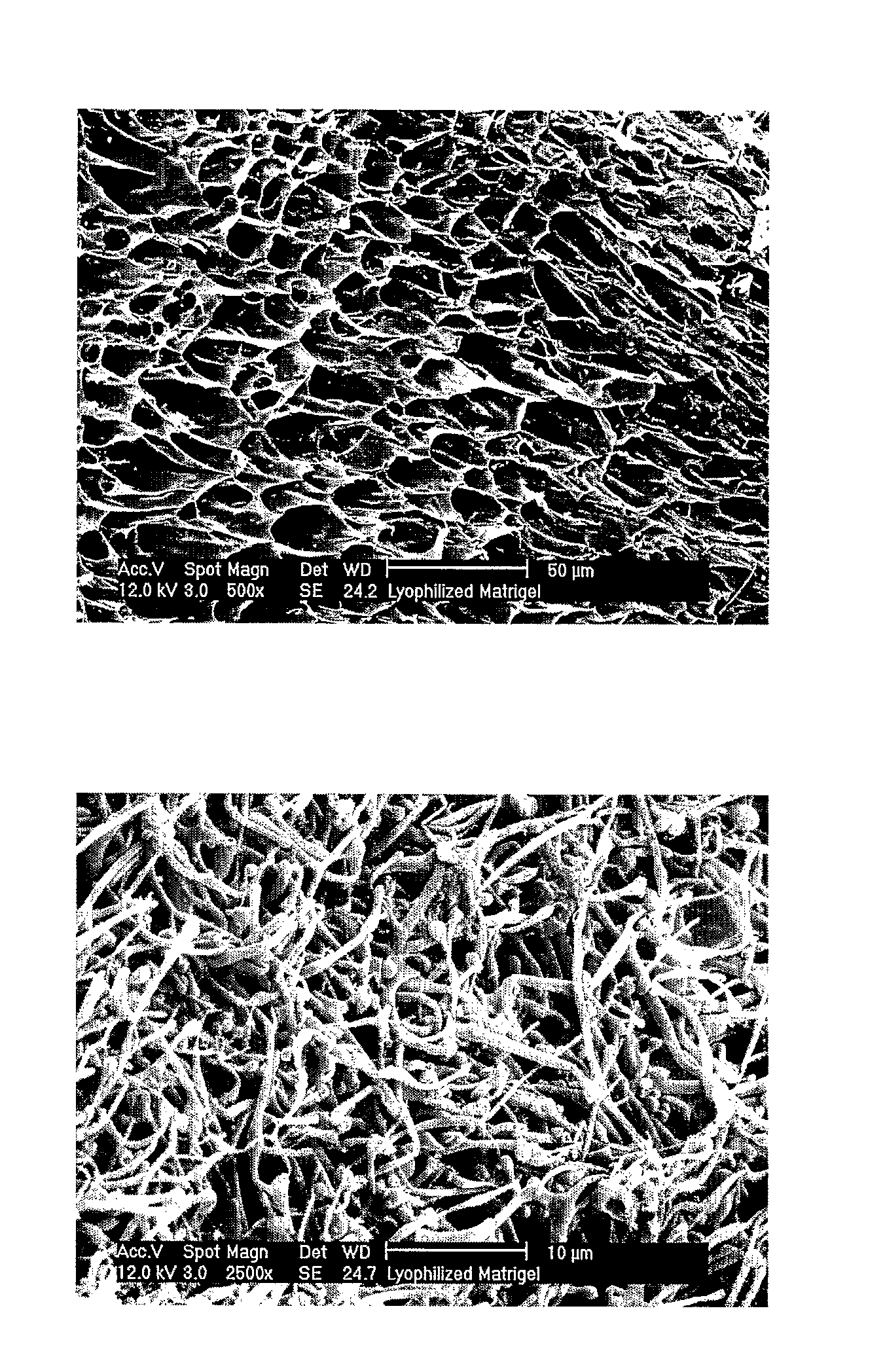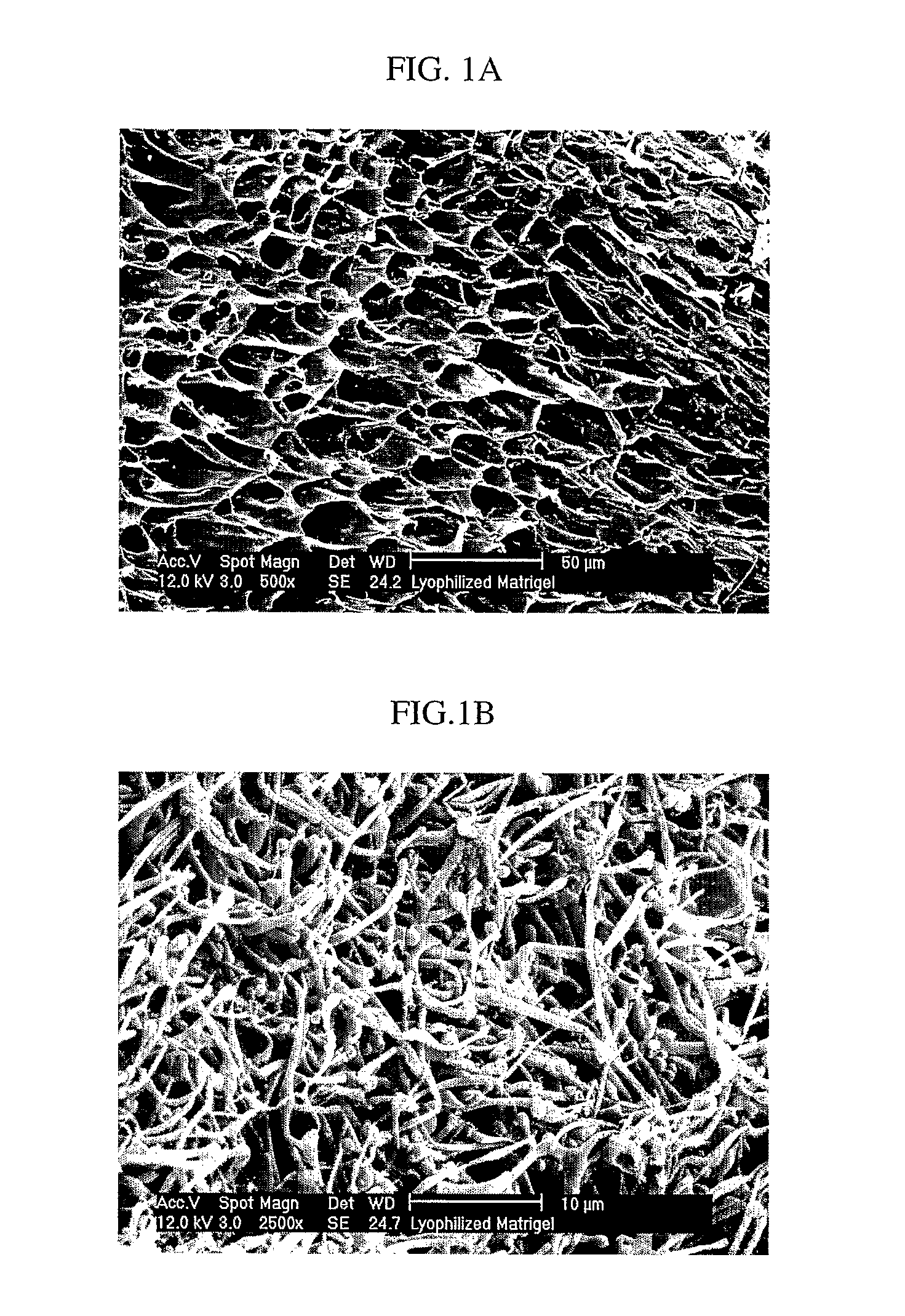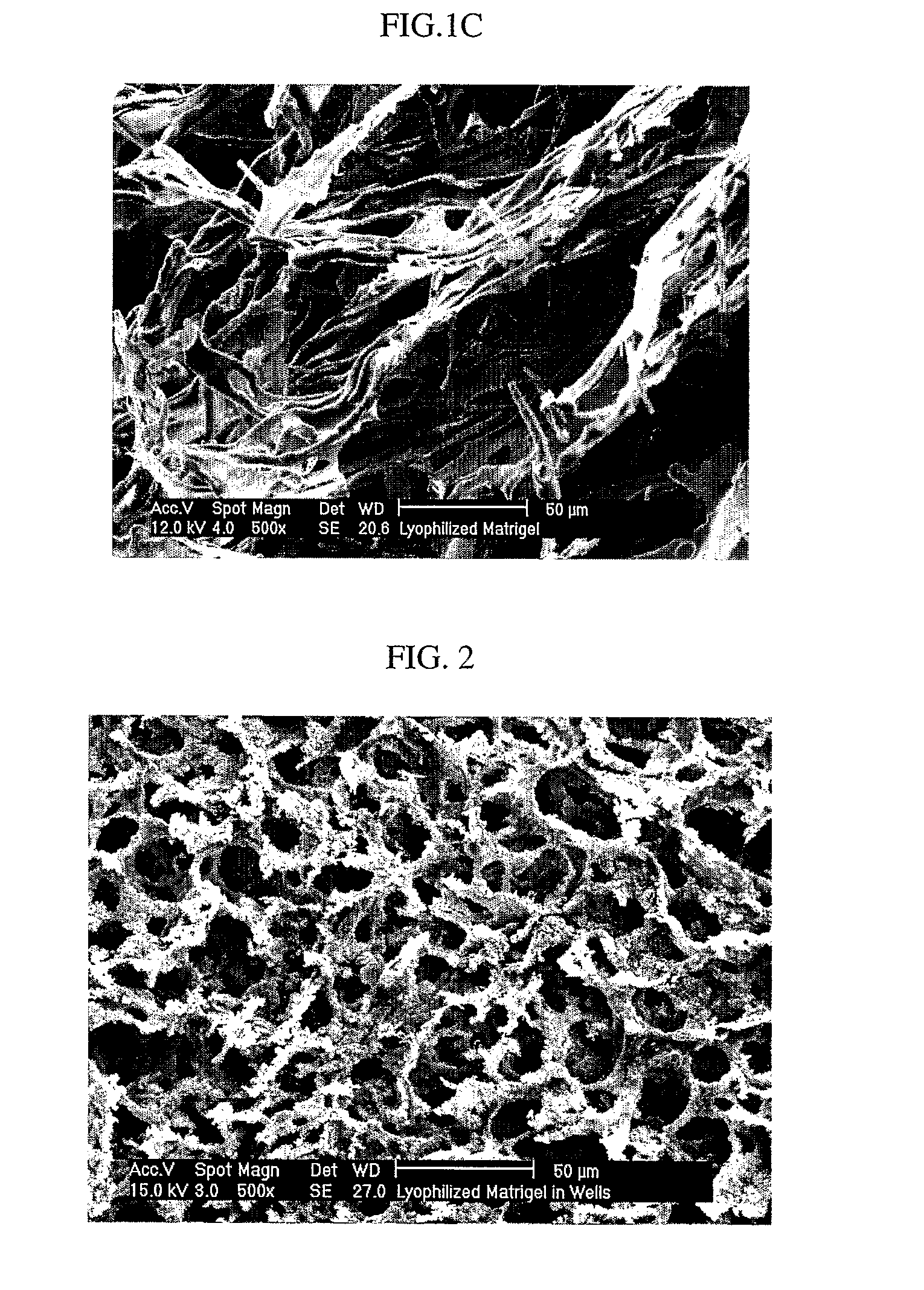Three-Dimensional Scaffolds for Tissue Engineering Made by Processing Complex Extracts of Natural Extracellular Matrices
a technology of extracellular matrix and complex extracts, which is applied in the field of three-dimensional nanofibrous scaffolds made from complex extracellular matrix, can solve the problems of not being useful as a scaffold for tissue engineering purposes, and achieve the effects of avoiding immune complications, good mechanical properties, and facilitating cell penetration and proliferation
- Summary
- Abstract
- Description
- Claims
- Application Information
AI Technical Summary
Benefits of technology
Problems solved by technology
Method used
Image
Examples
example 1
[0201]Preparation of basement-membrane-derived extracellular composition from EHS mouse tumor can be made using the method described in U.S. Pat. No. 4,829,000.[0202]1. Making buffers:[0203]3.4 M NaCl buffer (stock):
3.4M NaCl397g2M Tris pH 7.425ml0.004M EDTA3.0g0.002M NEM0.5g (N-ethylmaleimide)Add dd H2O to 2 liters and adjust pH to 7.4[0204]2 M urea buffer (stock):
2M urea 240 g0.05M Tris-base12.1 g0.15M NaCl 18 gAdd dd H2O to 2 liters and adjust pH to 7.4[0205]Tris-saline buffer (must be fresh):
0.05M Tris-base12.1 g0.15M NaCl18.0 gAdd dd H2O to 2 liters and adjust pH to 7.4[0206]2. Weight 50 g tumor, defrost if require (from −80° C.), and homogenize in 200 ml 3.4M NaCl buffer, all in 4° C. (keep the ratio as 1:2 w / v)[0207]3. Centrifuge at 7000 rpm, 4° C., 15 min, ×3 times. Each time, discard the supernatant and add the same amount of 3.4M NaCl buffer into the centrifuge tube, then balance the weight on ice.[0208]4. Collect the final precipitate, stir in 50 ml 2M urea buffer for ov...
example 2
[0217]Preparation of Basement Membrane from Human Placenta can be Made as Described in from U.S. Pat. No. 4,829,000.
[0218]Extracts comparable in composition and in biological activity can also be obtained from human placenta using a process similar to that used for the EHS mouse tumor described in Example 1. However, since placenta is not composed of pure basement membrane like the EHS mouse tumor, an additional step is necessary as described hereunder:
[0219](a) Placenta is freed of cord and amnion.
[0220](b) Placenta is then washed and homogenized in about 3.4M NaCl in 0.05M Tris-HCl, pH 7.4 containing standard protease inhibitors such as phenylmethyl sulfonyl fluoride; n-ethylmaleimide EDTA, pepstatin and the like.
[0221](c) The tissue residue is extracted overnight at about 4° C. with an equal volume (g / ml) of 0.5M NaCl in 0.05M Tris-HCl, pH 7.4.
[0222](d) The tissue after buffer extraction is washed with an equal volume of the same buffer and combined with the extract.
[0223](e) The...
example 3
Electrospun Lyophilized Matrigel Scaffolds in Organic Solvent
FIGS. 1A-C, 2, 3A-3B, 4A-4H, and 5
Solution Preparation:
[0225]Thawed 25 ml MATRIGEL at 4° C. or use the extracted MATRIGEL directly after extraction.[0226]Freeze MATRIGEL in the liquid nitrogen fume for 15 minutes.[0227]Lyophilized (Freeze-dried) MATRIGEL in a lyophilizer for 2 days.[0228]Dissolved lyophilized Matrigel in 1,1,1,3,3,3 Hexafluoro-2-Propanol (HFP) and stirred in ˜50° C. water-bath for overnight.[0229]The concentration is about 20% to about 30%.[0230]Waited for one day, and take the supernatant for electrospinning.[0231]Electrospun Procedure:[0232]Electrical field: 10 kV[0233]Air distance from syringe tip to target collector: 10-15 cm[0234]Delivery rate of matrigel solution: 0.5 m / h-1 ml / h
PUM
| Property | Measurement | Unit |
|---|---|---|
| Temperature | aaaaa | aaaaa |
| Temperature | aaaaa | aaaaa |
| Temperature | aaaaa | aaaaa |
Abstract
Description
Claims
Application Information
 Login to View More
Login to View More - R&D
- Intellectual Property
- Life Sciences
- Materials
- Tech Scout
- Unparalleled Data Quality
- Higher Quality Content
- 60% Fewer Hallucinations
Browse by: Latest US Patents, China's latest patents, Technical Efficacy Thesaurus, Application Domain, Technology Topic, Popular Technical Reports.
© 2025 PatSnap. All rights reserved.Legal|Privacy policy|Modern Slavery Act Transparency Statement|Sitemap|About US| Contact US: help@patsnap.com



